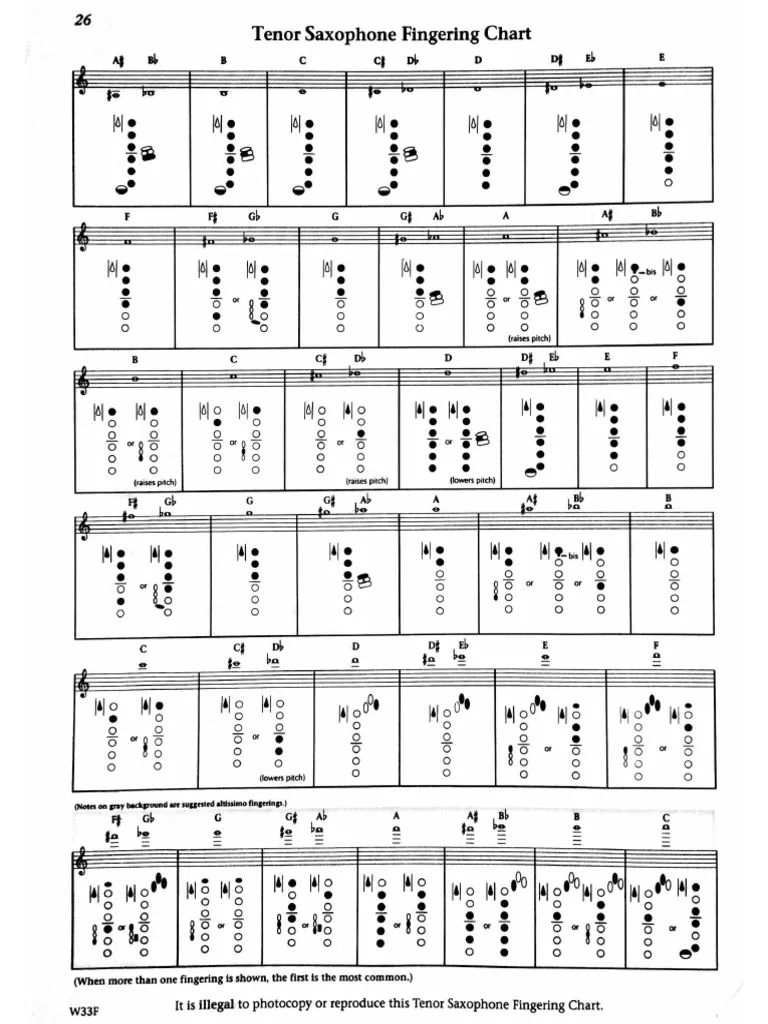The tenor saxophone is a popular instrument known for its rich, warm sound and versatility across various music genres. Whether you’re a beginner or an experienced player, understanding the fingering chart is essential for mastering the instrument. This article provides a comprehensive overview of the tenor sax fingering chart, helping you navigate the notes and improve your playing skills.
What is a Tenor Sax Fingering Chart?
A fingering chart is a visual guide that shows which keys to press on the saxophone to produce specific notes. Each note corresponds to a particular finger position, making it easier for players to learn and remember how to play different pitches. For beginners, this chart serves as an invaluable tool for developing muscle memory and improving overall technique.
Understanding the Layout of the Tenor Sax Fingering Chart

The tenor saxophone fingering chart can be broken down into several sections:
- Lower Register: This includes notes from low B to high D.
- Middle Register: This covers notes from middle C to high G.
- Upper Register (Altissimo): This section includes higher notes that require advanced fingerings.
Below is a simplified version of the tenor sax fingering chart:
| Note | Left Hand Fingers | Right Hand Fingers |
|---|---|---|
| Low B | 1 (Index) | |
| Low C | 1 (Index) + 2 (Middle) | |
| Low C# | 1 (Index) + 2 (Middle) + 3 (Ring) | 4 (Pinky) |
| Low D | 1 (Index) + 2 (Middle) + 3 (Ring) | |
| E | 1 (Index) + 2 (Middle) + 3 (Ring) + Octave Key | |
| F | 1 (Index) + 2 (Middle) + Octave Key | |
| F# | 1 (Index) + Octave Key + Side Key | |
| G | 1 (Index) + Octave Key + Side Key | |
| A | 1 (Index) + 2 (Middle) + Octave Key | |
| B | 1 (Index) + 2 (Middle) + 3 (Ring) + Octave Key | |
| C | 1 (Index) + 3 (Ring) + Octave Key | |
| D | All fingers down with Octave Key pressed |
Basic Fingerings for Common Notes
Here are some basic fingerings for common notes on the tenor saxophone:
- Low B: Press the left-hand index finger.
- Low C: Press the left-hand index and middle fingers.
- D: Press all three fingers on the left hand.
- E: Press all three fingers on the left hand and use the octave key.
- F: Use the same fingers as E but without pressing down the octave key.
- G: Use the left-hand index finger and press down the octave key.
Altissimo Fingerings
As you advance in your playing, you may want to explore altissimo fingerings, which allow you to reach higher notes. Here are some examples:
- High F#: Left-hand index finger with right-hand pinky.
- High G: Left-hand index and middle fingers with octave key.
- High A: Left-hand index, middle, and ring fingers with octave key.
Tips for Using the Tenor Sax Fingering Chart
- Print It Out: Keep a printed version of your fingering chart handy during practice sessions.
- Practice Regularly: Consistent practice will help you memorize finger positions more quickly.
- Use Visual Aids: Consider marking your saxophone keys with stickers that correspond to notes on your chart for quick reference.
- Play Scales: Practicing scales using your fingering chart can help reinforce muscle memory.
Conclusion
The tenor sax fingering chart is an essential resource for any saxophonist, especially beginners. By familiarizing yourself with this chart and practicing regularly, you’ll develop greater confidence in your playing abilities. Remember that mastering fingerings takes time and patience, so keep practicing and enjoy making music with your tenor saxophone!
This guide not only provides a clear understanding of how to read and use a tenor sax fingering chart but also emphasizes its importance in developing your skills as a musician. Happy playing!

